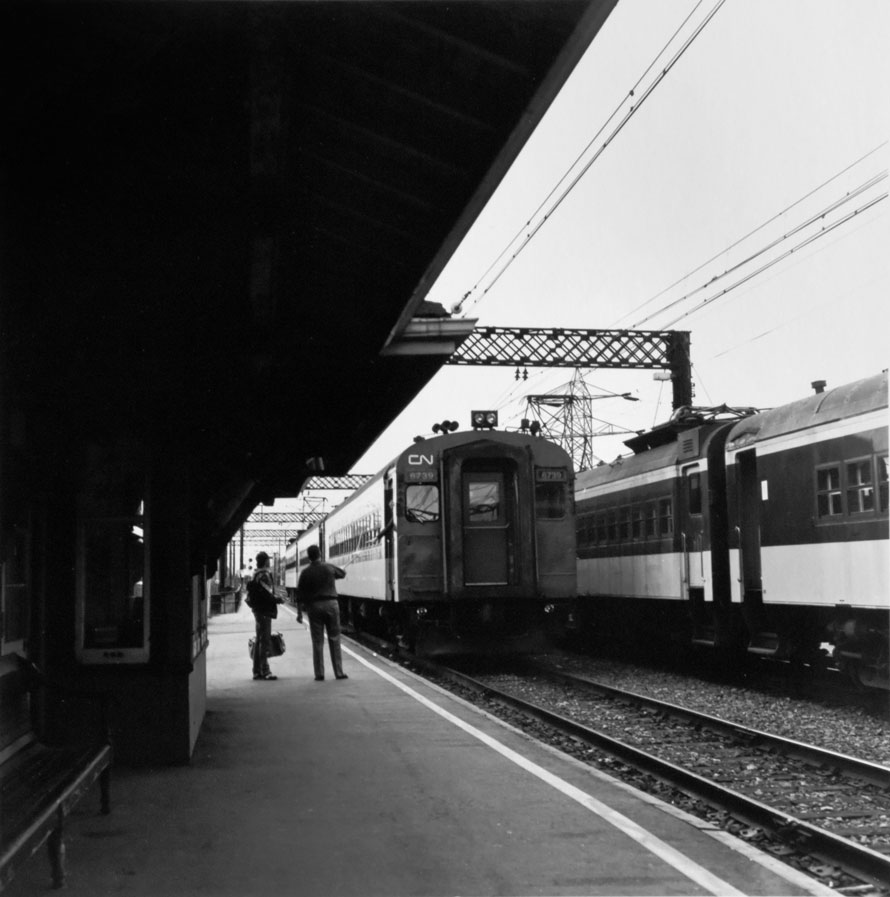
I first met George Hiotis in October of 1994 on the station platform at Val-Royal, a suburban neighborhood northwest of the center of Montreal. He and I had separately and independently decided to travel there to see for ourselves the electrification on the former Canadian National Deux-Montagnes commuter line. Four of the boxcab locomotives that we photographed dated back to 1917, built by General Electric; another handful had a foreign pedigree, constructed by English Electric in 1924; and the “modern” three steeplecabs, also GEs, came out of the Erie plant in 1950. On top of the ancient equipment, Val-Royal remained one of the last places in North America where a station agent hooped up orders to every inbound train. It felt like a trip in a time machine.
I do not remember the exact moment of our meeting, but George and I quickly hit it off and spent most of three days together and almost entirely at the station, where we let the trains come to us. He also gave me use of the second bed in his room at the one-star Motel Pierre just down Boulevard Marcel-Laurin. (I had come north intending to camp out but found the nearby provincial park closed for the season; I spent one night at a monastery and the next at a youth hostel downtown, where I found my German roommates noisy and otherwise unpleasant.)
After Montreal, George and I stayed in touch, but once my wife and I had our first child, and a couple of years later our second, I took a dozen years off from “serious” photography (although I did go through probably a thousand rolls of color print film documenting the children). In the summer of ’03, George and his girlfriend, Amy, visited us at our house in rural central Pennsylvania, and he and I took a day to go out to Renovo, on the former Pennsylvania Railroad Buffalo Line, to explore the remains of the huge shops complex there. We found them already partially demolished, although we counted no fewer than six overhead cranes still in place in the otherwise empty buildings that remained. We also found a couple of large gears lying outside half covered by gravel. The straight-cut one, five inches thick and less than a foot in diameter, weighs only ninety pounds or so, but we could barely move the other, a bevel gear measuring twenty-four inches across and six inches deep. Nonetheless, it ended up in the back of my Ford Escort wagon, which noticeably sagged under the load. The gears have served as lawn ornaments ever since.
In late 2009, I went digital and started spending more time at trackside, relearning the art of railroad photography, and in 2012 George suggested we take a road trip together. He wanted to revisit sites along the former Chesapeake & Ohio in West Virginia that he knew from earlier travels, and along the way we could check out other places of interest, like the Western Maryland Scenic and Cass. We spent most of a week on the road in my Ford Focus station wagon, staying in Cumberland, Maryland, (the first and last nights, at a Motel Pierre-esque caravansary on the hill outside of town and directly across the street from a cemetery); Cass, West Virginia, (two nights, in the lumber-company houses now maintained by the state park—and for atmosphere we have never found any better place anywhere); and Beckley, West Virginia, (another Pierre-esque establishment run by a shirtless man whose rotundity and East Asian cooking have stuck in our heads and nostrils ever since).
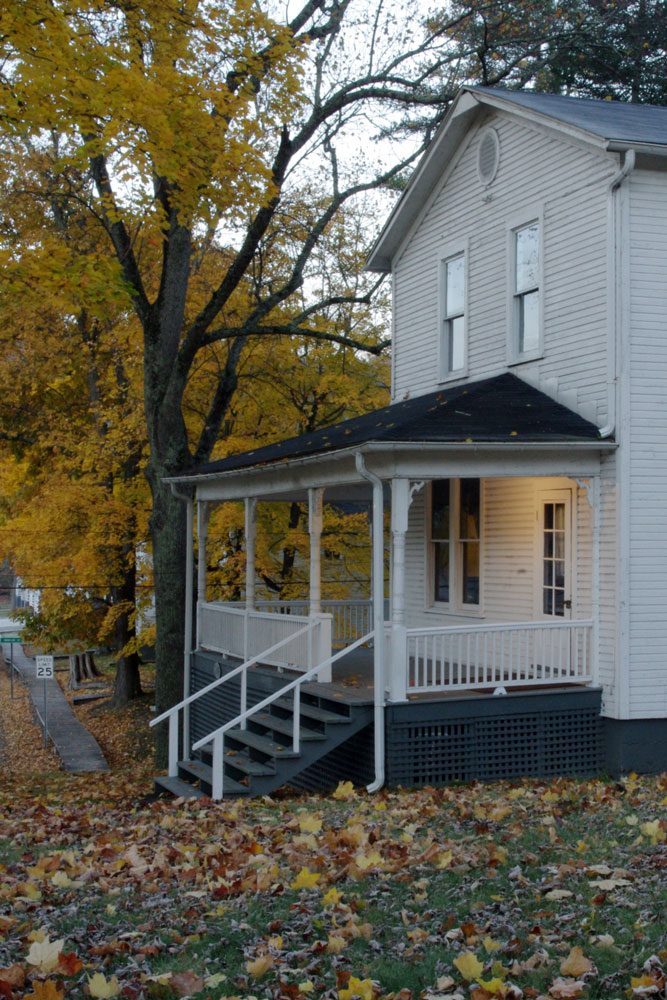
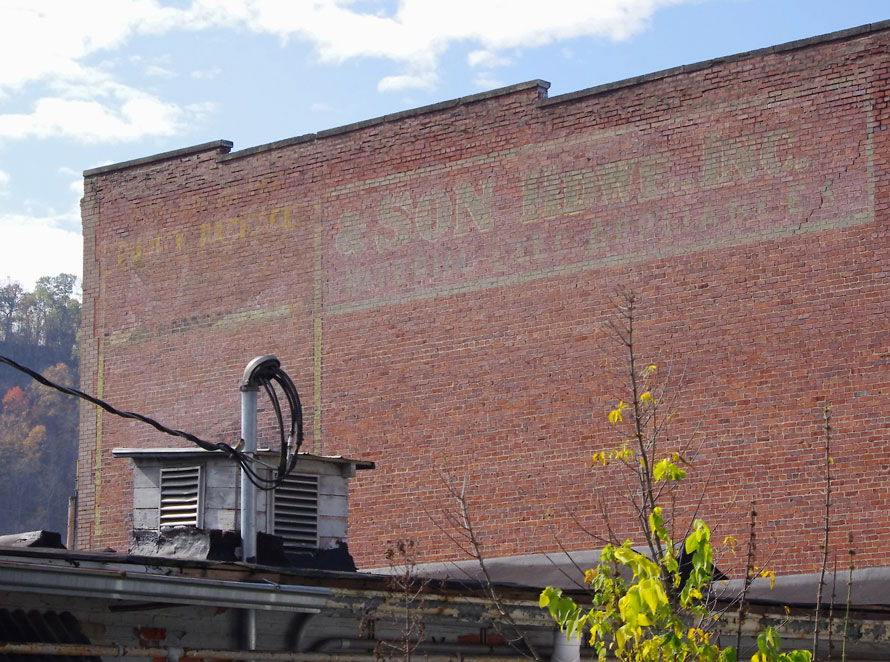
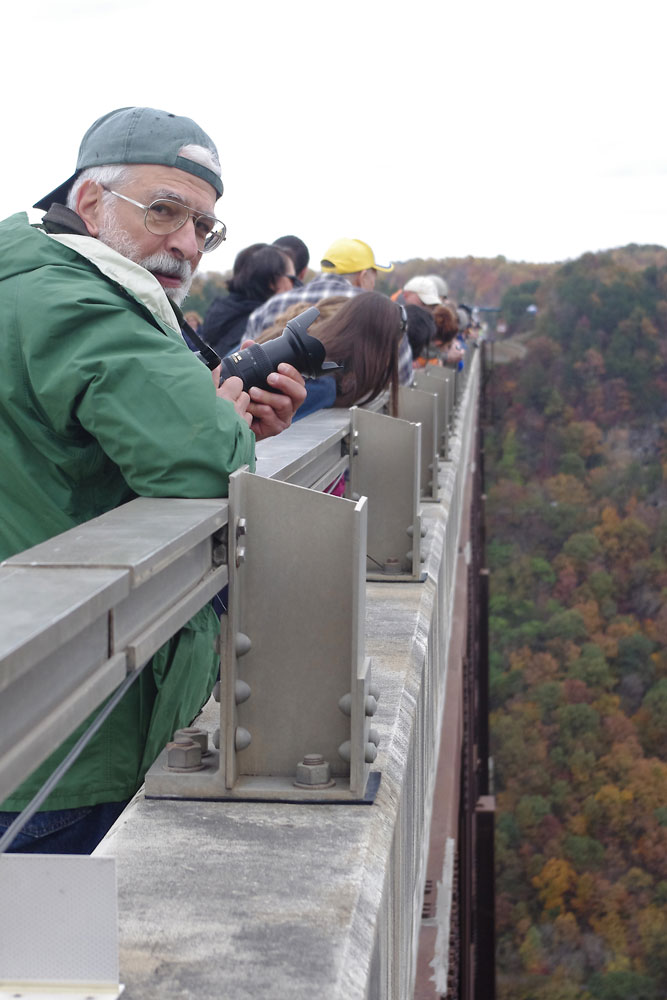
For the most part we stayed pretty close to the tracks, although the 1200-mile trip did contain kernels of the sort of broader explorations we would do in the future: Both George and I like to talk, to each other and to anyone else, and among other people we met we had an interesting conversation with the diner waitress in Ronceverte, West Virginia, about the origin of the town’s name. We also got lucky and happened to hit the New River Gorge on Bridge Day, the one day of the year when the 876-foot-high Route 19 arch bridge closes to vehicular traffic and pedestrians can cross it. The event attracts 100,000 people, and we walked through the throng and watched BASE jumpers launch themselves into empty space. After a week together, and best of all, we realized that we make very good traveling companions, interested in the same things, capable of making conversation more or less continuously for days at a time, easy to please about food, and unaccountably absent habits that grate on the other.
George made a career as a professional photographer from the late 1960s into the 2010s, largely as an assistant to other photographers, and he traveled the world. His iPad has a vast trove of images from here, there, and everywhere—George with U.S. Presidents, with athletes, in Charles Manson’s cell, on the back of a camel, you name it. That same iPad has an even vaster and, to a railroad photographer, utterly eye-popping trove of his train photos, most of them scanned from black & white negatives and color slides. George got his first camera at age thirteen, a 2¼-format Yashicamat, and he had an innate ability from the very beginning to make great images. His photos from that year of liners and tugs at the North River piers in New York City made even Victor Hand’s eyes bug. In the late 1950s and into the early ’60s, before he got a driver’s license, George and a friend would ride their bikes from home in Mountainside, New Jersey, to the Pennsy main line tracks in Rahway and vicinity where they photographed GG1s, P5s, and Baldwin Sharknose diesels. Once mobile by internal combustion, George’s horizons expanded, and in 1961 he chased his first steam train, one of the Reading Rambles in the Anthracite Region of Pennsylvania (armed with only an Esso road map – because what else would one have in those innocent days). That same year, he and a friend ventured as far as Horseshoe Curve.
We made our next great trip together in the spring of 2016, to and from the Center for Railroad Photography & Art conference in Lake Forest, Illinois—an eleven-day, 2200-mile odyssey on which we photographed trains and buildings in Bellevue, Berea, Deshler, Fostoria, and Sugarcreek, Ohio; Chicago, DeKalb, Nelson, and Rochelle, Illinois; Gary and Michigan City, Indiana; and Pittsburgh, Pennsylvania. Right after the conference, we also made a brief visit to Madison, Wisconsin, to drop in on Tom Garver, known as O. Winston Link’s assistant and business manager and the founding curator of the Link Museum in Roanoke. We didn’t stop long enough in Tom’s hometown to do more than admire his wonderful abode and have supper with him, but everywhere else I would say that we got a pretty good sense of the lay of the land—centered on the tracks but extending out into the adjacent areas and countryside. Just by dint of driving the “blue highways” instead of the Interstates, and looking around, we saw extraordinary things. And because George and I share the same philosophy about traveling, which I would summarize as “we’ll get there eventually,” we had no qualms about pulling to the side of the road and jumping out of the car, cameras in hand, whenever something caught our eyes. Thus our lunchtime stop at a photogenic barn with an even more photogenic rusty Cadillac sitting out front, facing the Lincoln Highway just a few miles west of Rochelle. And our three visits over two evenings and a day to the Egyptian Theater in DeKalb, not to mention the city’s public library, which has a spectacular modern addition that bespeaks widespread citizen support, even love.
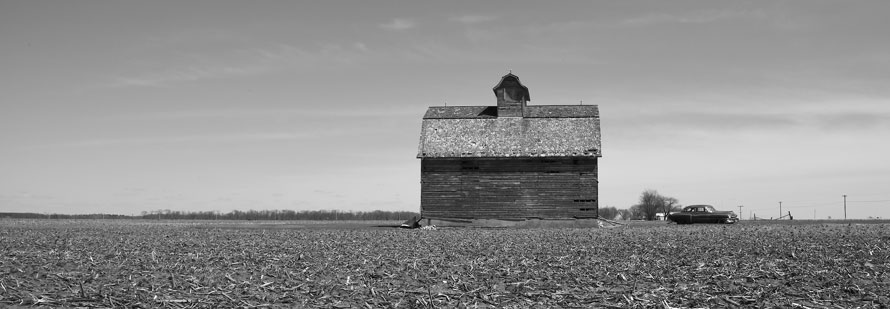
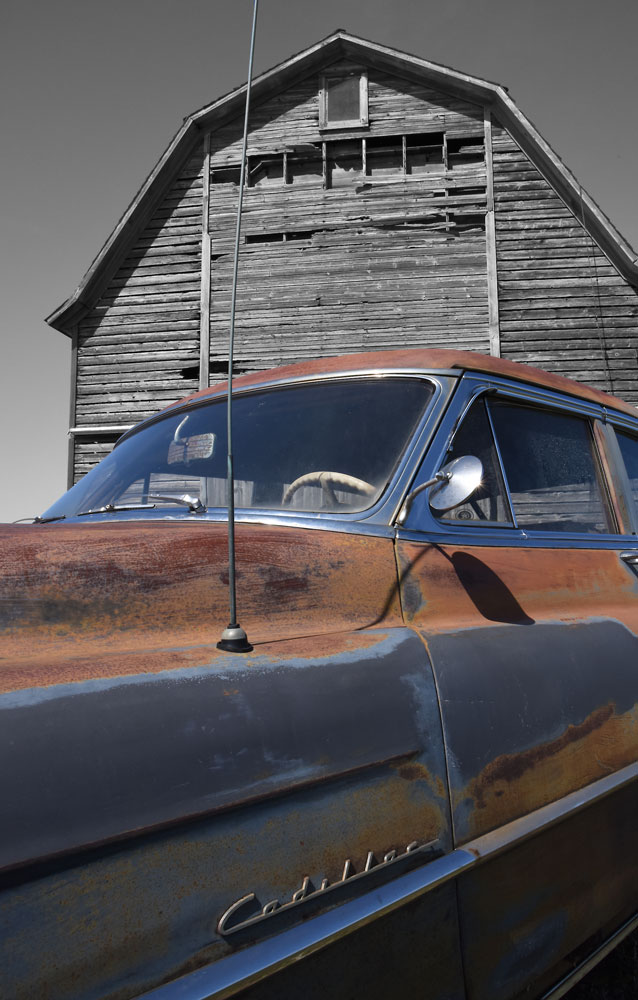
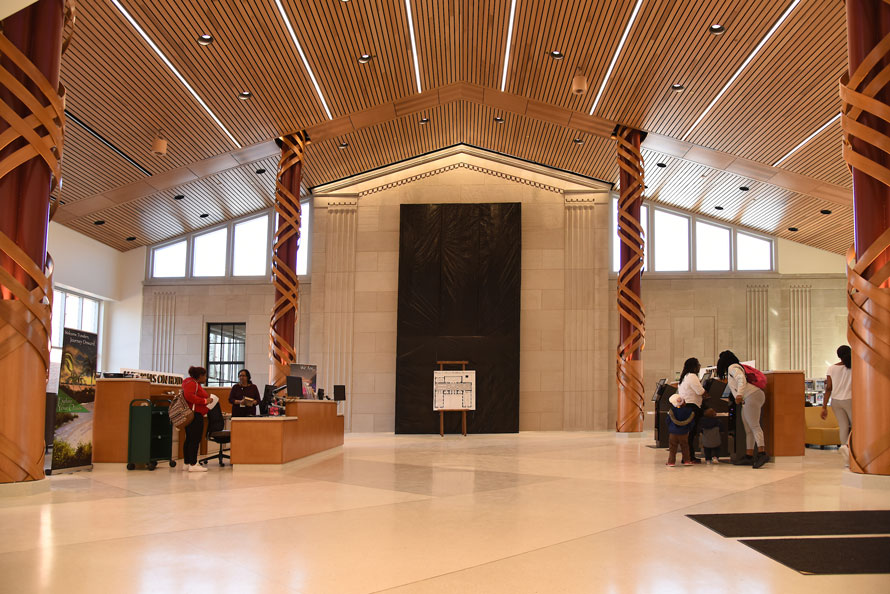
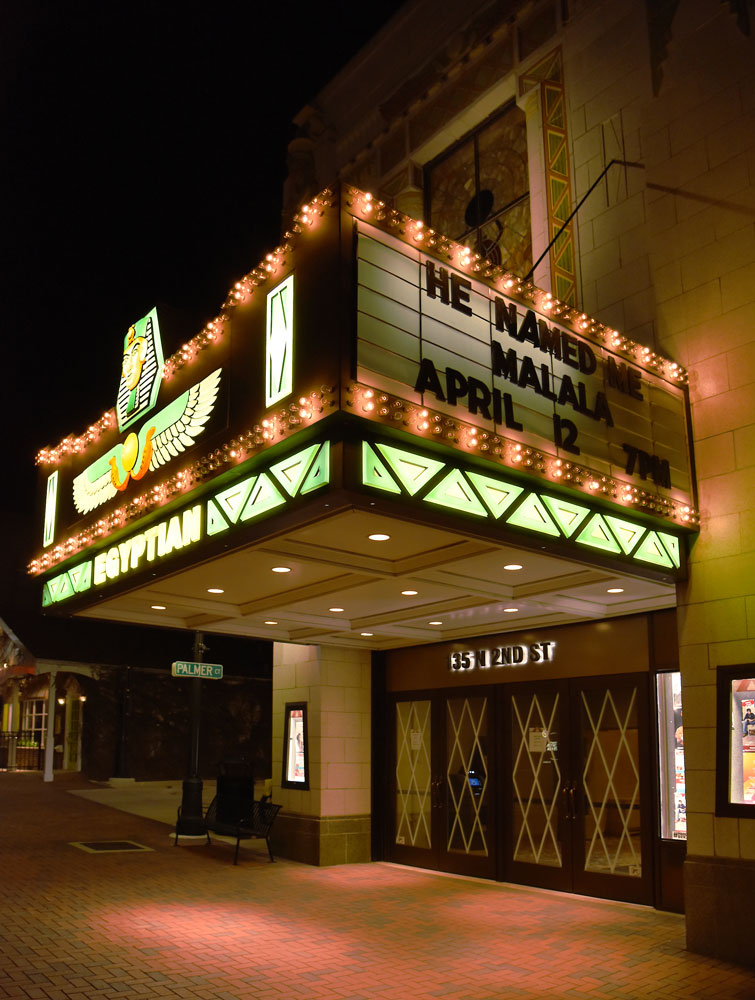
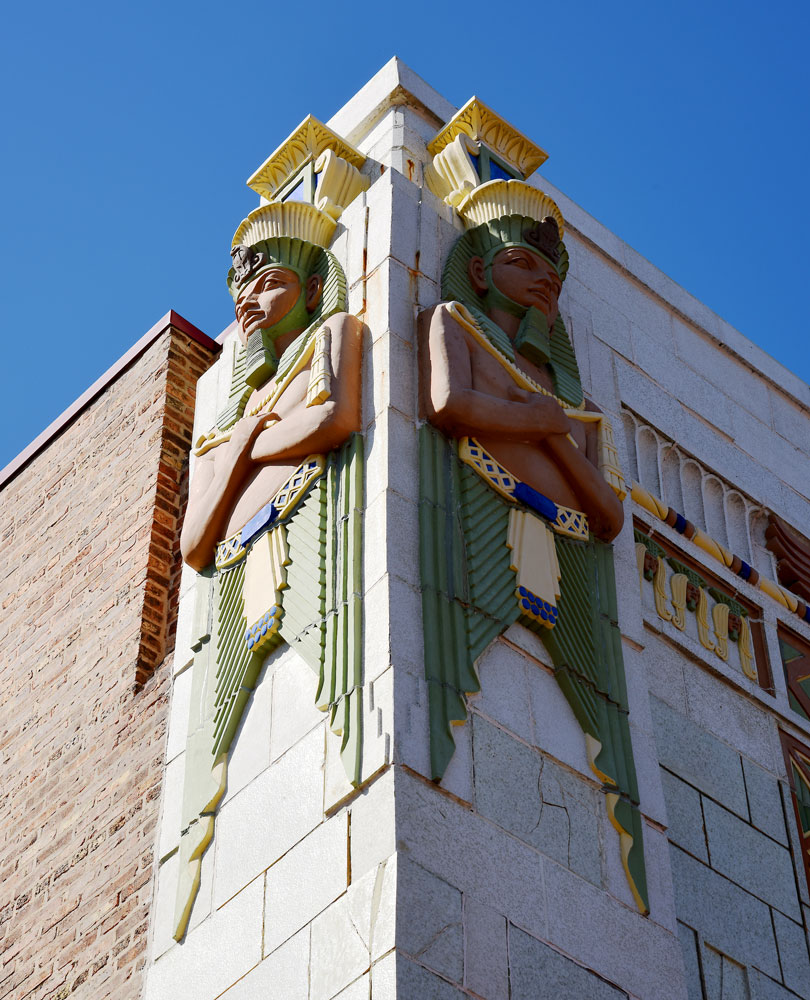
In 2017, we made two trips—the first, a weekend jaunt across Pennsylvania that started at the East Broad Top, where we joined a small group of photographers given a few hours of access to the roundhouse and shops. After a night at the Station Inn in Cresson, we followed the pilgrim’s route west along the Broad Way, the former Pennsy main. On the snowy January day, we thoroughly enjoyed seeing high-horsepower diesels muscling tonnage through the squalls, but the high point of the day came in Johnstown, another of the sad Rust Belt cities that have a magnetic pull on us.
On the street outside the Gautier Steel mill, once a part of Bethlehem Steel and a place of employment for 6000 people, we talked with a man who had once worked there, then moved to the company’s Sparrows Point mill outside Baltimore, then moved back home when he retired. Why anyone would come back to Johnstown I really cannot fathom; the city has lost more than 70% of its population since the peak almost a century ago, and Gautier Steel now employs 100—one hundred.
This retiree’s teeth also struck me, worn down to nubs—surely someone with a steel company pension could afford to go to a dentist? On the other hand, I do not know what sort of retirement “benefits” he gets, Bethlehem Steel having gone through bankruptcy and liquidation and all of its obligations to its retirees now covered by the Federal Pension Benefit Guaranty Corporation.
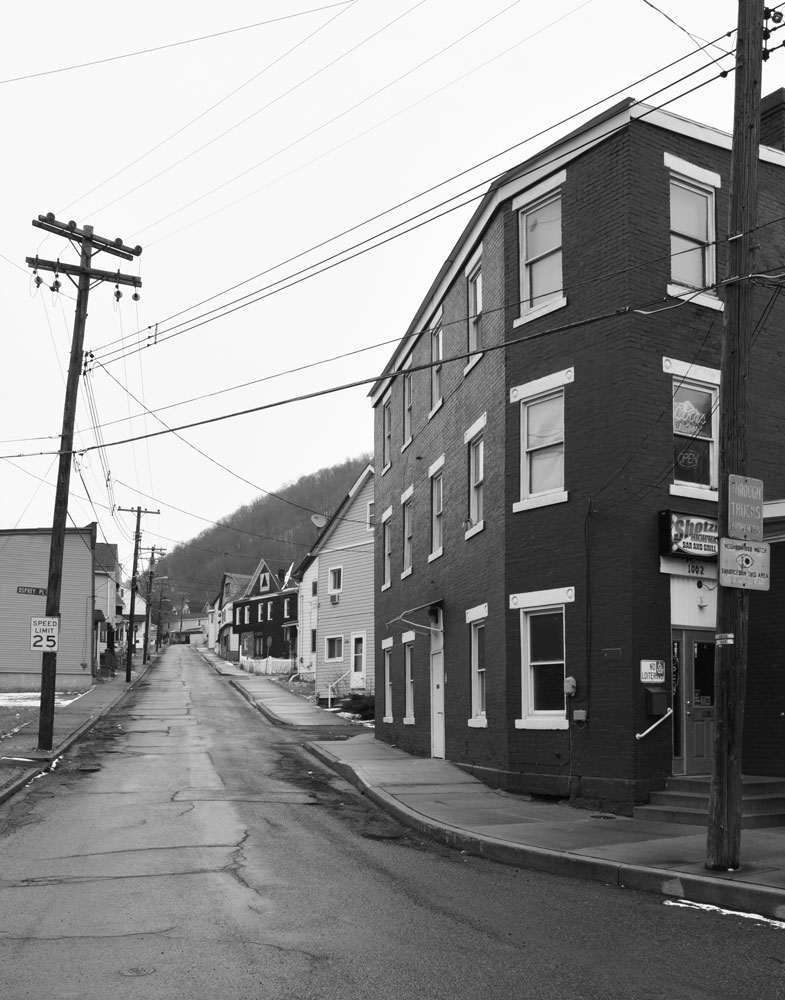
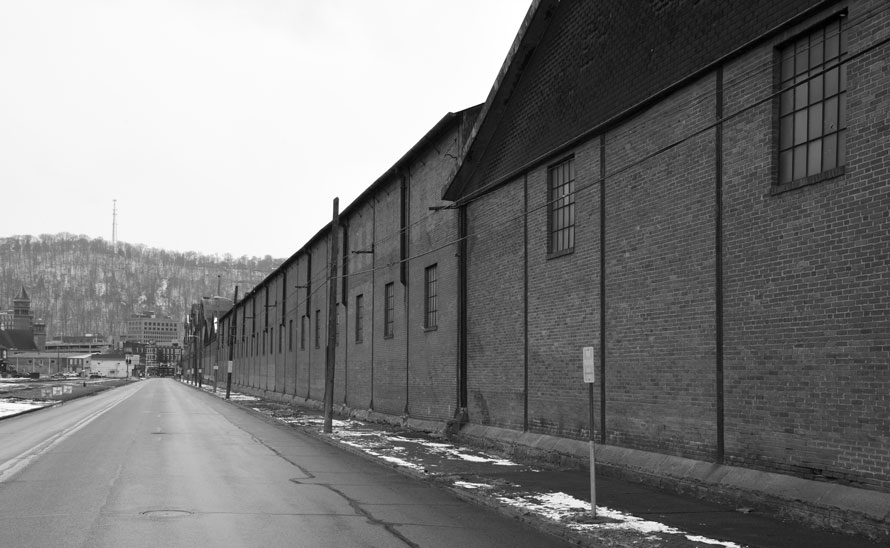
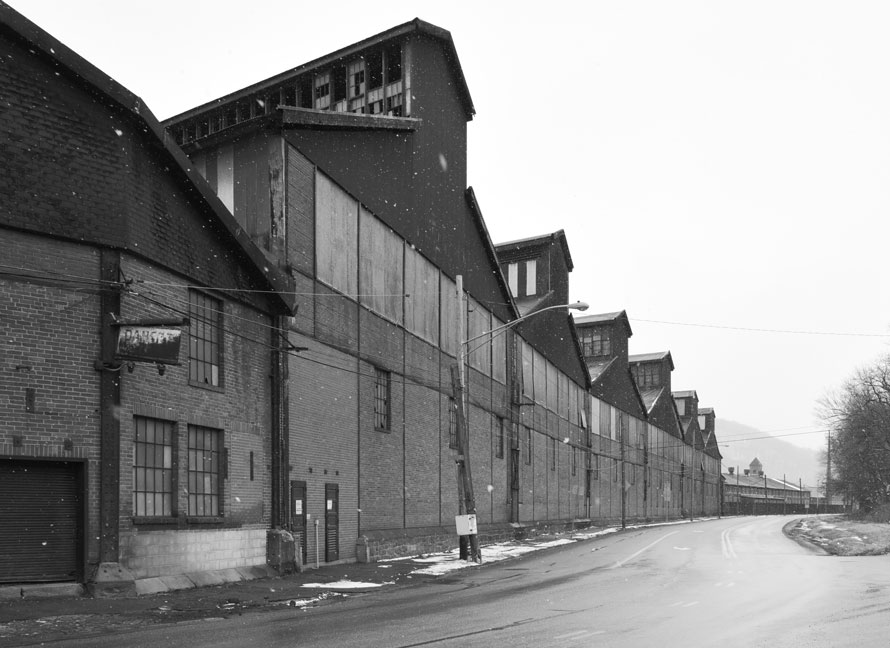
That spring, we made our second trip to a Center for Railroad Photography & Art conference, this time with stops in Bucyrus, Crestline, Deshler, Fostoria, Leipsic, Marion, and Sidney, Ohio; Frankfort, Michigan City, and Union City, Indiana; Chicago, Illinois; Augusta, Durand, Lansing, and New Buffalo, Michigan; and Pittsburgh and environs (Braddock and Homestead)—all crammed into only eight days, including the conference. Although we did not venture as far west as we had in 2016, we made a loop northward into Michigan on the way home, seeking out more concrete coal docks like we had seen in DeKalb and Nelson. For all of these trips, George does extensive research ahead of time—now on the Internet rather than on Esso road maps. (But he does still look at United States Geological Survey maps, which George has a huge collection of, all marked up with highlighter and ball-point and all keyed to the pages of “test shot” slides that he made over the decades.) The USGS maps and xeroxes of the test shots accompany us, along with a looseleaf binder of directions, maps, train schedules, and sunrise and sunset times. For all of the labor that he puts into this planning, though, George does not consider the binder as binding but rather as a framework around which and within which we build our journey—the flexibility which embodies our style of peregrination.
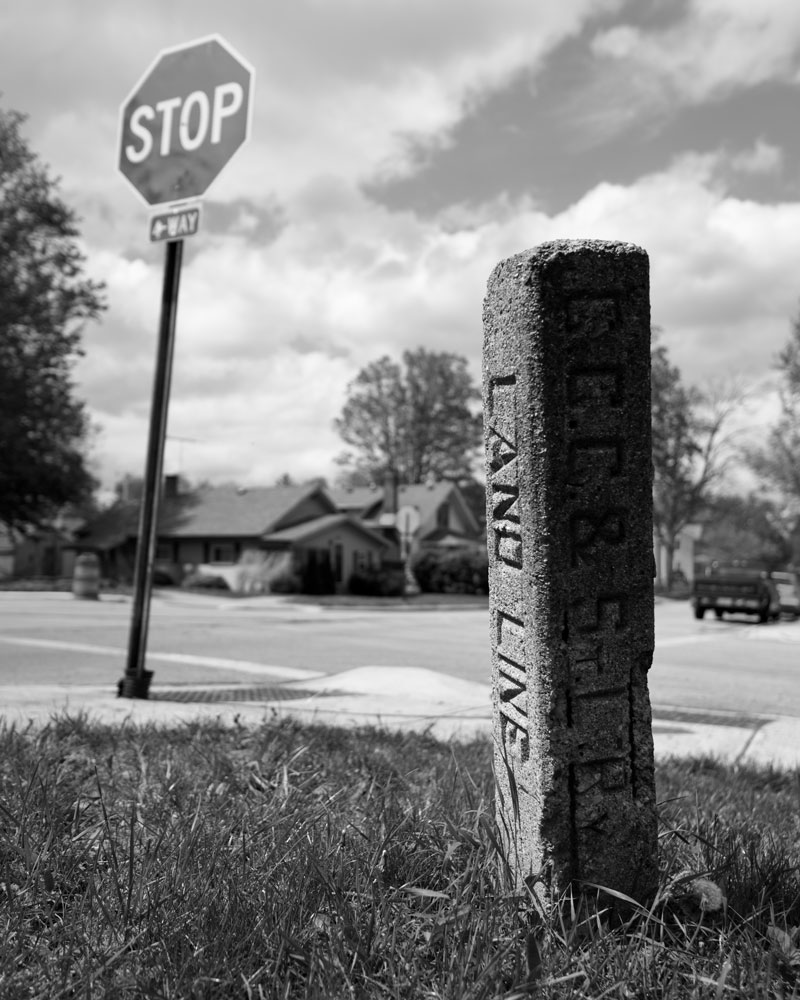
The most memorable personal interaction we had on the 2017 trip took place on the second day out, in a residential neighborhood in Sidney, Ohio (home to one of the best of the Louis Sullivan designed jewel-box banks, which sits on the square facing a Second Empire style courthouse and across the street from The Spot, a neon-bedecked hamburger joint that you MUST eat at when you pass through town).
As we photographed the cast-concrete property marker that the Big Four (Cleveland, Cincinnati, Chicago & St. Louis) set into the ground in the early 1920s, a young woman came over from her house to ask after our line of work. We explained our fascination with all things railroading, even down to such a literal landmark (which in Sidney sits well above and out of sight of the tracks, which run in a deep cut that bypassed downtown and eliminated trackage in the Miami River floodplain). From the young woman, whose name I sadly did not note, we learned of the opioid and heroin epidemic sweeping through the area. The very property marker before us adjoined a grim reminder of it in the form of a bouquet of plastic flowers and a cross planted in the grass—the memorial to a nineteen-year-old girl from nearby, once an outstanding student who got hooked on drugs and just recently had thrown herself in front of a train in the cut below us. Our source, probably not yet thirty-five years old but with five children of her own between five and fifteen years old, had moved into her grandparents’ house—the house she had wanted to live in her whole life, the one across the street from where we stood. But now she wanted to get her kids the hell out of Sidney and move to the country a ways west of town where she hoped to insulate them from the forces that could lead them to the same fate as the dead girl. She said she and her boyfriend (not the father of any of her children) had a place in mind and she would not mind the forty-five-minute commute to her nursing job in Sidney which she would get once she finished school. We wished her luck, and I hope her relationship with the boyfriend lasts and that her job satisfies her and that her kids do indeed grow up and prosper.
On our last day out, we made our last stop in Braddock, south of downtown Pittsburgh and one of the saddest places we have ever seen. Although the Edgar Thomson Works, Pennsylvania’s only remaining blast furnace, continues in operation at the edge of town, like Gautier Steel it employs many fewer than in years past, and Braddock has lost ninety percent of its population, down to just a couple of thousand. The main street has almost as many empty lots as buildings, and more abandoned buildings than occupied ones. Nonetheless, the community rallied to save the Carnegie Library – the very first to open of the 1,689 that Carnegie paid for in the United States. As we looked around, the children’s librarian engaged us in conversation and then took us on a tour behind some locked doors into the board room, with its portrait of “Andy,” and a 600-seat auditorium on the top floor, only marginally restored but already a sought-after wedding venue. If they can make it there, they can make it anywhere.
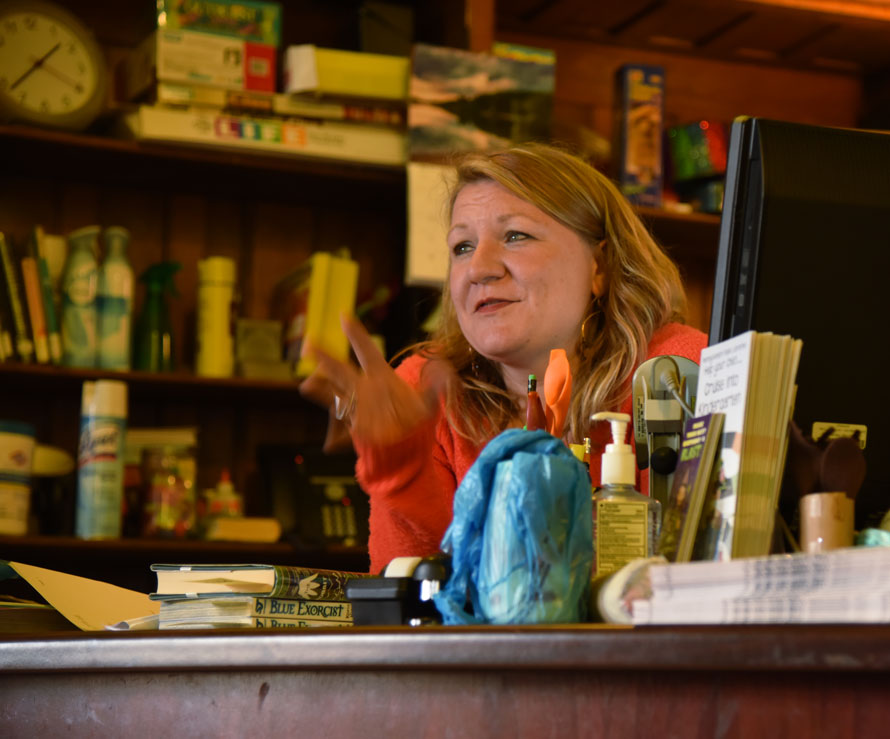
In 2018, our CRPA odyssey stretched out to two full weeks—the longest trip away from home I had made since before getting married. We stopped in Braddock, Dubois, East Pittsburgh, Girard, Homestead, McKees Rocks, and Pittsburgh, Pennsylvania; Akron, Bellaire, Cleveland, Fostoria, Kent, Liepsic, and Youngstown, Ohio; Taylor, Michigan; Frankfort, La Porte, Michigan City, and Walkerton, Indiana; Blue Island and Chicago, Illinois; and South Wheeling and Wheeling, West Virginia. You may have noticed that, along with Chicago, we keep going back to some of the same places. And yes, some places keep calling us back, because we keep finding more to see. Michigan City, say: the South Shore electric commuter trains run right down a main street, for more than a mile, and the houses and commercial buildings and churches and brick-paved streets make for fascinating surroundings. On the 2018 trip, we went to Michigan City both on the way out to Chicago and on the way back, photographing both in town and on the outskirts, in daylight and after dark. On the way back east, after more than a week on the road, we stopped one morning at a laundromat on Michigan Boulevard to refresh our kit. While our clothes agitated, rinsed, spun, and tumbled, we talked with Carolyn, the attendant, born in the vicinity “in the back of a ’57 Chevy”, she told us. She had lived in Michigan for a time and then came back. She had an uncertain living situation, describing herself as “not homeless,” and she contemplated finding a motel room to live in, thinking it “cheaper than a house” once one counted the cable and NIPSCO bills. Carolyn had had a tall father and grandfather, and all of her kids had grown up tall—between 5’-6” and 5’-11” for the girls, 6’-2” and 6’-6” for the boys. Now she had thirteen grandchildren as old as thirteen years and as young as two and a half weeks. I sent her multiple copies of the photo I made of her, to distribute among her children. She gave me an actual street address to mail them to but I never heard from her.
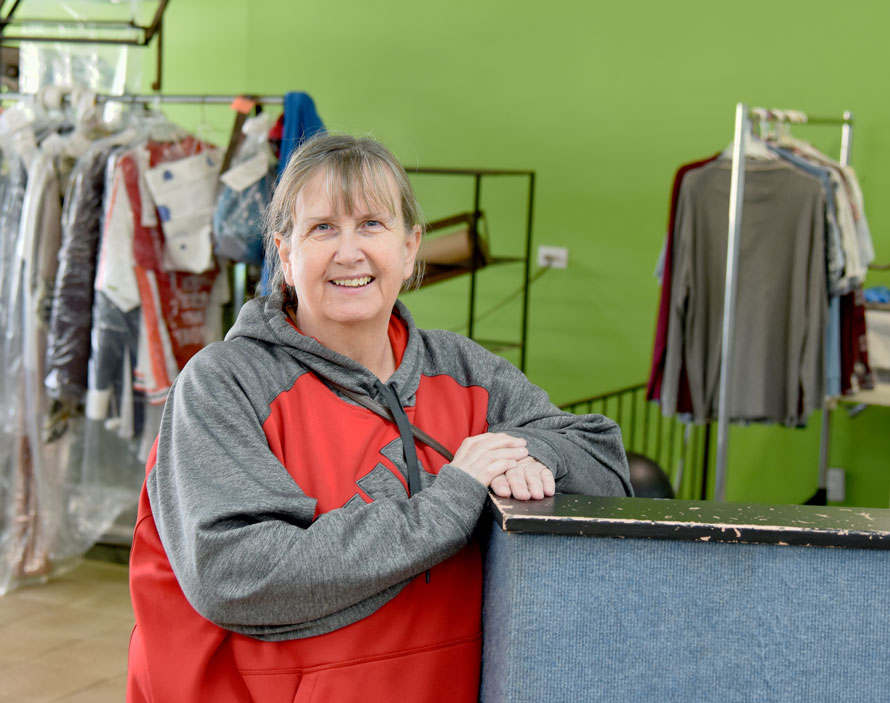
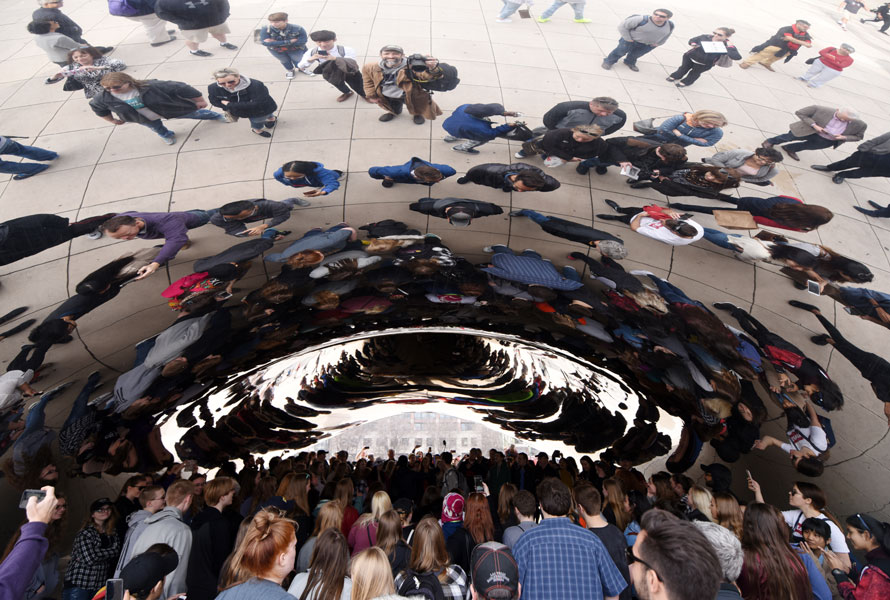
In Chicago, we had spent a cloudy afternoon in Millenium Park, at the Bean—a most unlikely landmark but apparently the most-visited site in the city and in the entire Midwest. The park as a whole now sees more than twenty-five million people annually, half as many as Times Square in New York, but eight times as many as the Grand Canyon. During our time there, we made a few photos of our own, but I mostly helped other people make theirs. I saw so many couples and families holding up their phones, trying for group selfies or with one person left out of the picture because someone had to take it, that I started volunteering to take their pictures for them. Over the course of a couple of hours, I took pictures of probably fifty groups, and I talked to people from Maine and San Francisco, Mexico and Iran and Thailand. Every now and then George would come over and say to my subjects “You know, he has fifty other people’s phones in his pockets,” but no one’s laughter came back as nervous. I can only describe the vibe of the whole place and everyone in it as joyful. Best of all, for me, the high-school choir from Wahpeton, North Dakota, in town for a competition over the following weekend, gave an impromptu concert standing under the Bean. I can honestly say that I have never seen anything like it.
The 2018 trip wrapped up with the excellent Earth Day that we spent in and around Pittsburgh; readers of The Trackside Photographer may remember “Sunday in the Car with George” which published in July 2018, and the people we met in McKees Rocks and North Braddock and East Pittsburgh. The week before the publication, George and I spent a weekend in western Pennsylvania again—a reprise of our January trip in 2017, visiting the East Broad Top on Saturday and then heading out on the Broad Way again. This time we began Sunday west of Horseshoe Curve and worked our way east in weather diametrically opposed to the previous journey—beastly hot and sunny, rather than cold and snowy. We may have let the weather get the better of us, since in most locations we emerged from the air-conditioned car only long enough to make a few images before diving back into refrigerated comfort. The day ended away from the tracks, as the sun sank in the west, with a ride on the Millersburg Ferry across the Susquehanna between Harrisburg and Sunbury. I have ridden and photographed this treasure—the two last wooden-hulled sternwheelers operating in North America—often since moving to Pennsylvania in 1992, but George had never had the pleasure, and I chatted with our captain as George eagerly pointed his camera at everything.
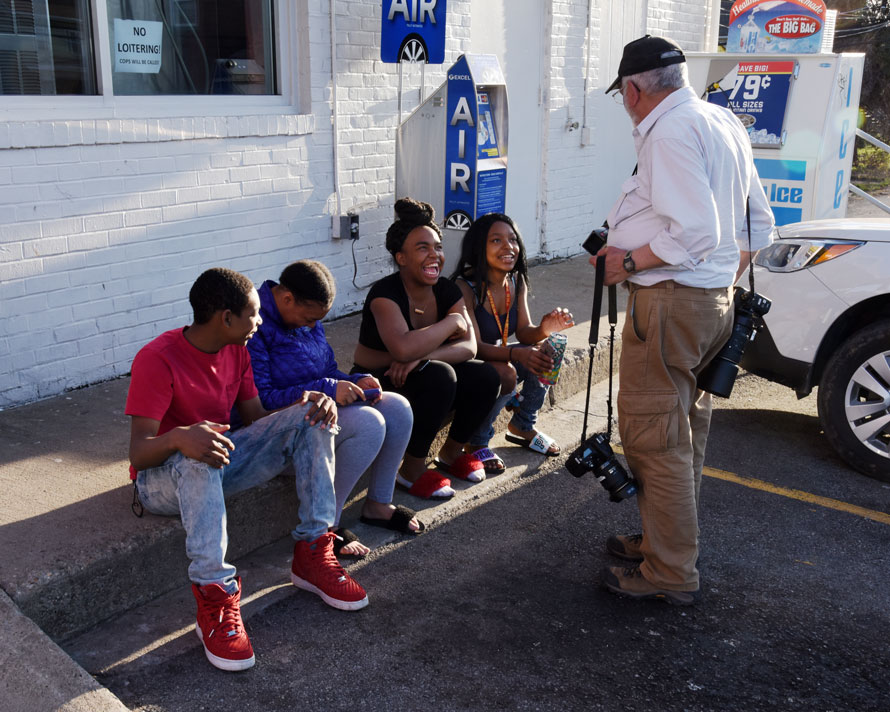
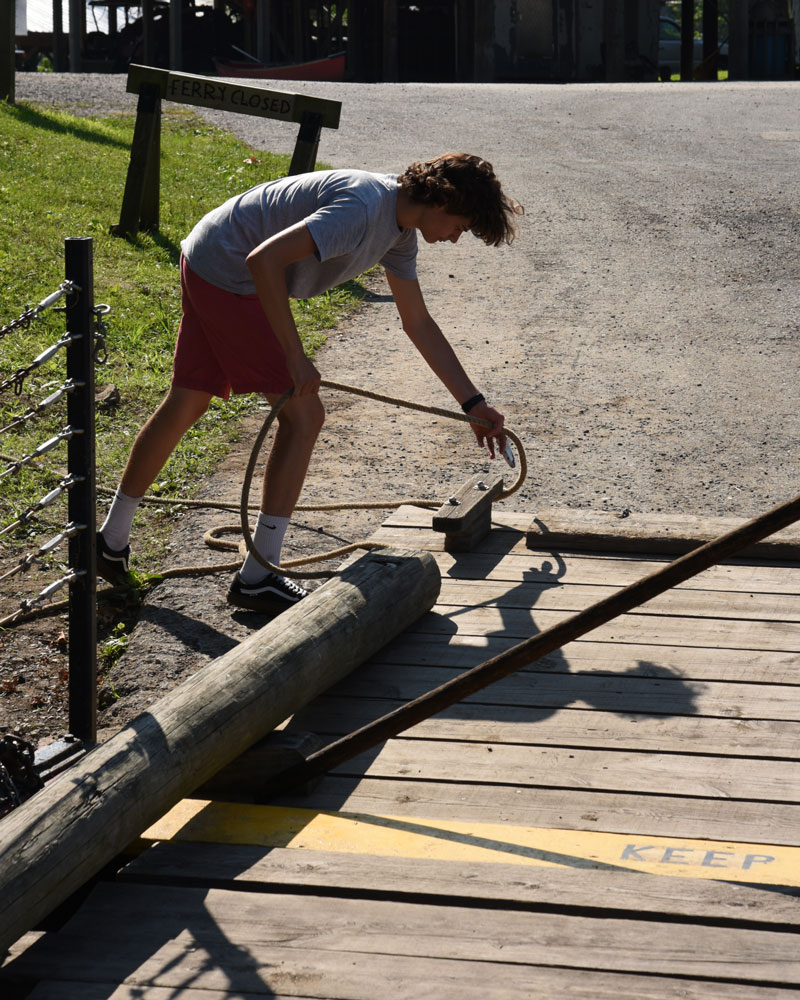
Because of the upcoming celebration of the 150th anniversary of the Golden Spike ceremony in Utah completing the Transcontinental Railroad, the Center for Railroad Photography & Art decided to hold two conferences in 2019—the first in the spring out West, concentrating solely on the 150th anniversary, and they moved the traditional “Conversations” conference, held near Chicago, to September. George and I did not want to drive to Utah—well, we did, but neither of us had the time available to do that justice—so we started planning our September trip. But then another opportunity arose, to join Tom Garver in Detroit for a tour of the Michigan Central station that Ford has bought to renovate as their electric-vehicle-design headquarters. This trip we did quickly, five days, out and back from Bloomsburg, but we still managed to make stops in Mercer, Pennsylvania; Akron, Bowling Green, Fostoria, and New Baltimore, Ohio; and Detroit, Jackson, Pontiac, and Taylor, Michigan. Leaving the Michigan Central station aside (it deserves a story of its own), the county courthouses in Mercer and Bowling Green made the trip’s highlights for me—utterly spectacular examples of American civic architecture, all marble and stained glass and bronze and murals, built at a time when we believed in the importance of government and the ability of a building to uplift all who entered or even saw its clock tower from afar.
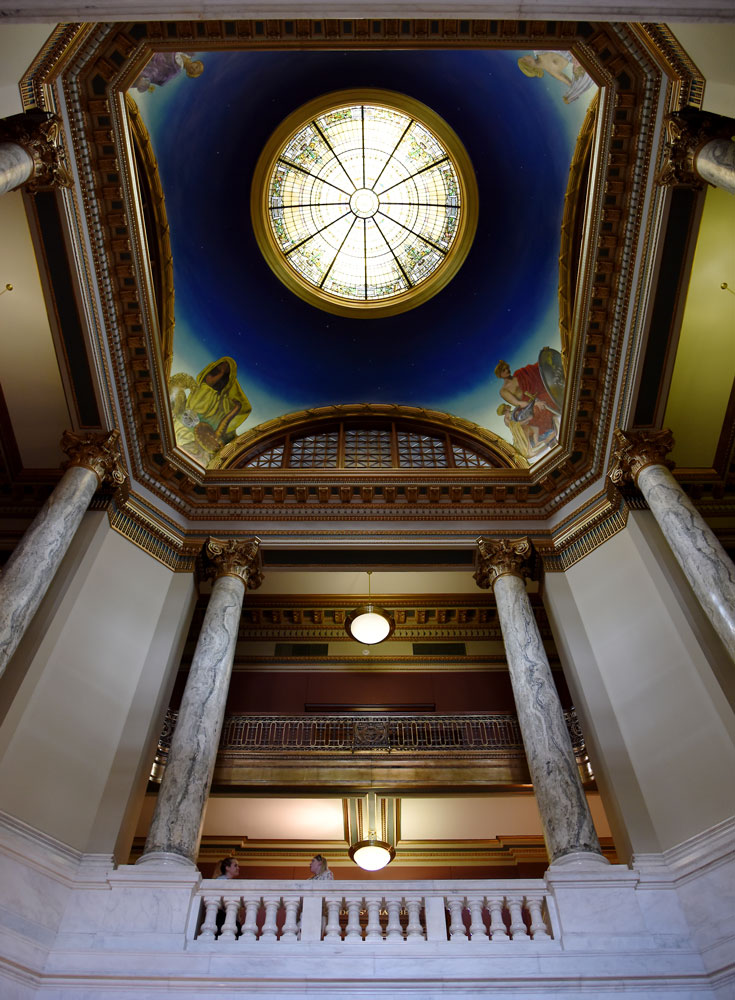
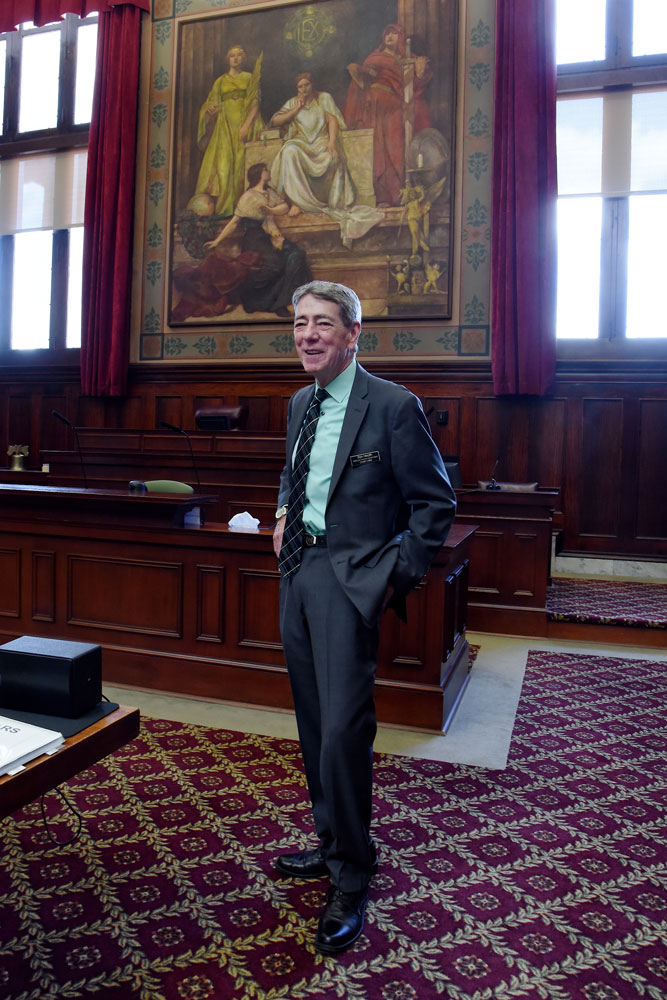
The Wood County courthouse in Bowling Green has one of the oddest clock-tower roofs I have ever seen, some sort of Swiss-influenced confection that tops out at 195 feet high. According to Wikipedia, “At the time of its construction [1893-96], the clock hands were the second largest in America, spanning 16 feet (4.9 m) in diameter.” This in a county whose population had not yet reached 50,000 when the courthouse opened; it finally reached 100,000 in the 1970s and has passed 130,000 recently.
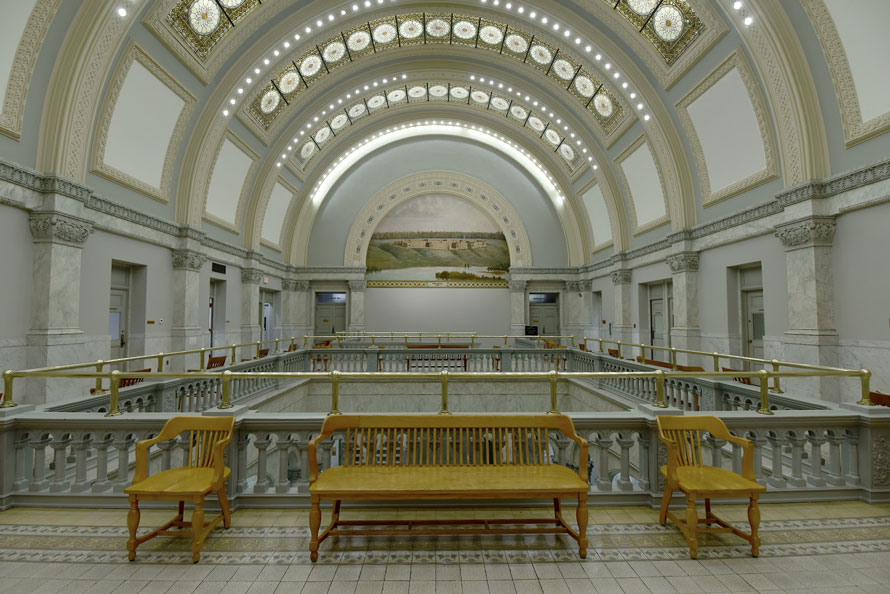
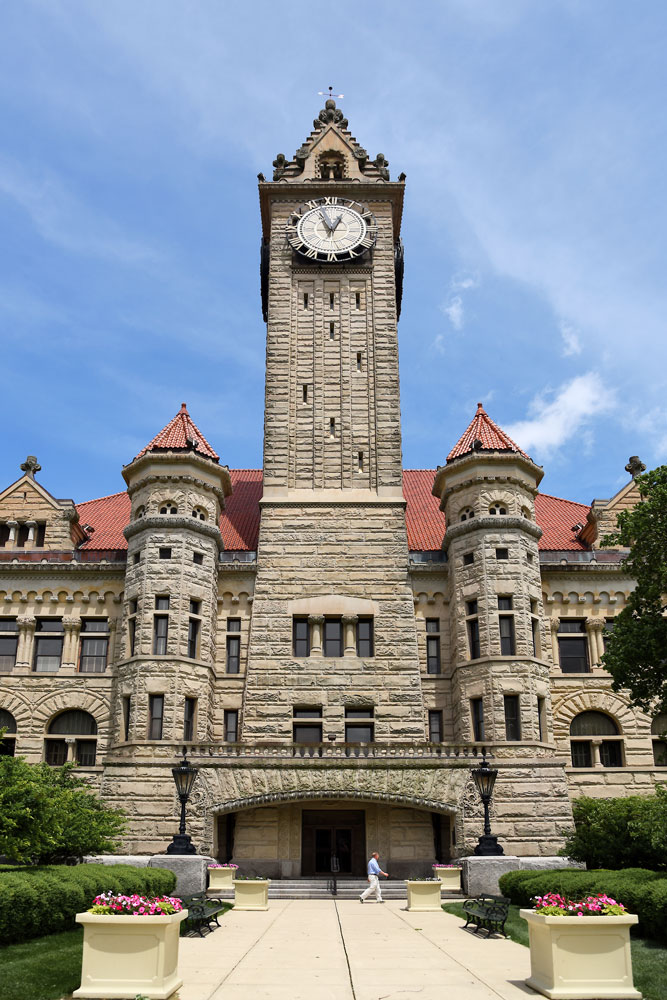
I would nominate train stations and county courthouses and city halls—at least those built between the Civil War and World War I—and to a much lesser extent 1930s post offices, as this nation’s secular temples. In all the courthouses we have visited—in Youngstown and Bowling Green, Ohio; Frankfort, Indiana; and Mercer, Pennsylvania—we have found the people working in them to have a deep sense of pride in the buildings, and a sense of gratitude to get to walk through the doors every day and into monuments to democracy.
For our September trip this year to and from the Center for Railroad Photography & Art conference, we plan to make our first stop in Cincinnati—yes, home to one of the great railroad terminals, but also to the world’s largest-ever steam-powered pumping engines, triple-expansion monsters 104 feet high and weighing 1400 tons. No doubt we’ll drop in at a few courthouses, and since this trip will stretch to seventeen days, we’ll need to do some laundry somewhere. I wonder whom we’ll meet along the way.
Oren B. Helbok – Photographs and text Copyright 2019
Delightful, throughout!
A very positive post! I carry an old (1957), Esso map (now laminated), with me when I travel through Southern Ontario. Many road changes, but the map shows the rail lines (which are now mostly abandoned). Lots to photograph but the friend I would like to explore with now lives in Saskatchewan. Thanks for the tour. Looking forward to one on the Michigan Central station in Detroit!
You recognized the most important aspect of this, sir: For all of the abandonments and what-once-was-and-never-more-shall-be that we see on our trips, we come home exhilarated by the sheer variety of what we have seen and the welcomes that we have received from the people everywhere. You can find more of my work (much more of it trains than anything else) at WhereSteamLives.net. Looking forward to sharing more here and there in coming months, and I wish you the very best on all of your own explorations!
Thank you, sir, and I cannot imagine a better response to this piece than yours: These trips do indeed delight George and me, and glad to know the telling delights others.
You have a great way of writing, sir. This was a pleasure to read and I was swept up your tales of discovery and delight. I appreciate people who go out with open eyes and open hearts to see the world around them.
Thanks for your comment, Traingeek, very glad that you appreciate this story, and you summarized our approach to a t: open eyes and open hearts.
Most of my time spent photographing trains and railroads has been a solo effort. I come and go as I please, not answering or waiting on anyone. This is when I’m both doing my own thing or on a photo charter – I tend to be away from the photo lines more than on them.
In the last few years I have opened up and started sharing experiences with the friends I have made along this journey. Oren is definitely one of them, who I first met when Nickel Plate 765 was last running out of Steamtown. We quickly hit it off and have grown close as the years have passed. Just last week we discussed getting together with Reading & Northern 425 and CNJ 113 this autumn. I look forward to both. Through Oren I met George, who lives just up the road from me in the same state.
Not sure if it’s right to put Oren and George in the same context as Lennon and McCartney or Gilmour and Waters, but the two consistently work their magic every time out, coming home with incredible stories and photographs from the adventures they share. A part of me is a bit jealous; wishing I had such a partnership of kindred spirits.
I am happy and proud to know them both.
Matthew
It seems funny to admit, Matthew, after I have written a piece that goes into such detail about so many years of experiences, but I did not remember that you and I met during 765’s visit to Scranton! You and I have had some great experiences together in the years since then — perhaps only a day at a time rather than in sustained doses, but just as precious (and I still owe you for the night I got the ride in the cab and you did not). Looking forward to our next adventure at trackside —
Wonderful story of all these travels! I’ve been to Bridge Day several times over in the New River Gorge, so this brought back happy memories. When you’re in Cincinnati, be sure to try the chili at Camp Washington Chili, close to the CSX Queensgate yard….
Thank you for the culinary recommendation, Steve — will check it out later this week!
Oren, what a wonderful narrative! The adventures through the cities what were once engines of the US industrial age were especially poignant. Your encounters with the residents still living in those towns and cities that have seen more prosperous times was very interesting. I greatly enjoyed your story about helping the selfie-takers with their cell phone photos. I still do the same thing – whenever I see someone trying to take a family photo but with the photographer not in the picture I am never refused when I offer to take the photo for them so everyone can be in it. The families are always grateful and appreciate the help, and without exception prove to be very nice people. You are lucky to have George as such a compatible travelling companion, and it is easy to imagine the two of you screeching to a stop outside of one photo op or another. So many people who drive only on the Interstates, or worse, see Fly Over Country from 35,000, never experience seeing the country and it’s people like they can on State roads or better yet, passenger trains. Enjoy Cincinnati, and please write another “Trip Report” when you get back. Very Well Done.
Just found your post here, Mr. Hughes, and very much appreciated. Glad to hear from someone else who takes joy in helping other people preserve their memories as photos (I almost wrote “on film” — some habits die hard). And yes, I consider myself supremely fortunate to have George for a companion. We came back from our most recent trip with 5000+ images each, and I have only edited a few — but I do have the first episode of the trip report done, and you can read it at wheresteamlives.net/pitler-street-pittsburgh; drop me a line after you have read it!